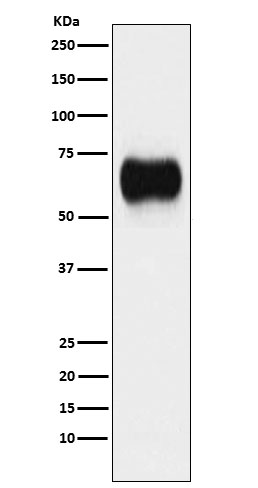
| WB | 1/1000-1/2000 | Human,Mouse,Rat |
| IF | 咨询技术 | Human,Mouse,Rat |
| IHC | 咨询技术 | Human,Mouse,Rat |
| ICC | 技术咨询 | Human,Mouse,Rat |
| FCM | 咨询技术 | Human,Mouse,Rat |
| Elisa | 咨询技术 | Human,Mouse,Rat |
| Aliases | PERB11.1; MICA;;MIC A |
| WB Predicted band size | Calculated MW: 43 kDa ; Observed MW: 42-70 kDa |
| Host/Isotype | Rabbit IgG |
| Antibody Type | Primary antibody |
| Storage | Store at 4°C short term. Aliquot and store at -20°C long term. Avoid freeze/thaw cycles. |
| Species Reactivity | Human |
| Immunogen | A synthesized peptide derived from human MIC A |
| Formulation | Purified antibody in PBS with 0.05% sodium azide,0.05% BSA and 50% glycerol. |
+ +
以下是3篇关于MICA抗体的代表性文献摘要:
---
1. **文献名称**: *Antibodies to MICA in HLA-antibody negative kidney transplant rejection*
**作者**: El-Awar, N. et al.
**摘要**: 研究证实抗MICA抗体可导致HLA抗体阴性的肾移植患者发生抗体介导的排斥反应,提示MICA抗体在移植免疫中的独立作用(New England Journal of Medicine, 2007)。
---
2. **文献名称**: *Clinical relevance of MICA antibodies in solid organ transplantation*
**作者**: Zou, Y. et al.
**摘要**: 分析MICA抗体在心脏和肾脏移植中的临床影响,发现其与移植物功能延迟恢复及慢性排斥相关(Transplantation, 2007)。
---
3. **文献名称**: *MICA antibodies in autoimmune diseases: mechanisms and biomarkers*
**作者**: Suárez-Alvarez, B. et al.
**摘要**: 综述MICA抗体在类风湿性关节炎和系统性红斑狼疮中的病理机制,提出其作为疾病活动性生物标志物的潜力(Frontiers in Immunology, 2013)。
---
4. **文献名称**: *MICA genetic polymorphism and anti-MICA antibodies in transplantation*
**作者**: Tilanus, M. et al.
**摘要**: 探讨MICA基因多态性对器官移植中抗体产生的遗传影响,强调基因分型对移植配型的潜在价值(Human Immunology, 2016)。
---
以上文献涵盖MICA抗体在移植排斥、自身免疫病中的作用及遗传机制,可帮助快速了解该领域核心研究方向。
MICA (MHC class I chain-related molecule A) is a stress-inducible cell surface glycoprotein belonging to the non-classical MHC class I family. It functions as a ligand for the activating receptor NKG2D, expressed on natural killer (NK) cells, γδ T cells, and CD8+ αβ T cells. MICA plays a critical role in immune surveillance by alerting immune cells to cellular stress, such as infections, malignant transformation, or tissue damage.
Antibodies targeting MICA arise in various clinical contexts. In autoimmune diseases like systemic sclerosis or vasculitis, anti-MICA autoantibodies may contribute to pathogenesis by inducing endothelial cell apoptosis or activating complement. In organ transplantation, MICA antibodies are associated with antibody-mediated rejection and graft loss, as MICA polymorphisms between donor and recipient can trigger alloimmunization.
Tumor cells often evade immune detection by shedding MICA via proteolytic cleavage, releasing soluble MICA (sMICA) that downregulates NKG2D-mediated immunity. Therapeutic anti-MICA antibodies are being explored to block sMICA or enhance tumor cell recognition. Conversely, MICA antibodies in cancer patients may paradoxically impair NK cell function, highlighting their dual role in immunity.
Detection of MICA antibodies is clinically relevant for transplant risk stratification and autoimmune disease monitoring. Research continues to elucidate their precise mechanisms and therapeutic potential in immuno-oncology and transplantation.
×